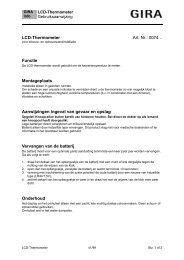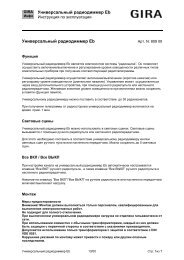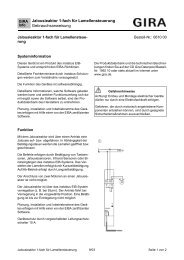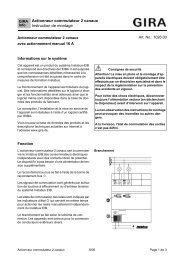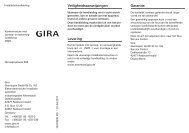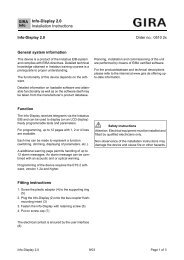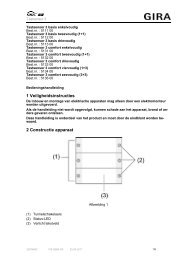Blind actuator 1-gang flush-mounted Order-No. 2165 00 - Gira
Blind actuator 1-gang flush-mounted Order-No. 2165 00 - Gira
Blind actuator 1-gang flush-mounted Order-No. 2165 00 - Gira
You also want an ePaper? Increase the reach of your titles
YUMPU automatically turns print PDFs into web optimized ePapers that Google loves.
Software "Venetian blind, input 20BD11"<br />
Functional description<br />
The feedback objects are not updated, if the position last reported back has not changed after a<br />
movement (for instance, when the Venetian blind is repositioned, the unchanged slat position<br />
will not be reported back a second time).<br />
The device cannot calculate a feedback position, if the current position data after switch-on of<br />
the bus voltage or after ETS programming are still unknown. In these cases, the system must<br />
first perform a reference movement (cf. "reference movement") so that the position can be<br />
calibrated. In case of unknown positions, the device automatically performs reference<br />
movements, if new positions are preset and if these positions are to be approached. As long as<br />
a position is unknown, the value of the feedback objects is "0".<br />
Presetting position feedback for Venetian blind, roller shutter, awning or venting louver<br />
positions<br />
The feedback functions can be enabled and programmed. When feedback is enabled, the ETS<br />
adapts the parameter texts depending on the preset operating mode<br />
("Venetian blind position feedback", "Roller shutter/awning position feedback" or<br />
"Venting louver position feedback"). The feedback can be used as an active message object or<br />
as a passive status object. As an active signalling object, the position feedback information is<br />
transmitted to the bus whenever a position value changes. As a passive status object, there is<br />
no telegram transmission after a change. In this case, the object value must be read out. The<br />
ETS automatically sets the object communication flags required for proper functioning.<br />
In case of an actively transmitting signalling object, the current position can be transmitted to<br />
the bus after bus voltage return, if the position value differs from the one last transmitted. When<br />
the position data are known, the feedback telegram can in this case be transmitted with a time<br />
delay to reduce the bus load, with the delay being preset globally for all outputs in common (cf.<br />
"Delay after bus voltage return").<br />
The feedback functions of an output must be enabled on parameter page<br />
"O1 - Enabled functions". Only then are the parameters for the feedback functions visible.<br />
o Set the parameter "Venetian blind position feedback",<br />
"Roller shutter/awning position feedback" or "Venting louver position feedback" on<br />
parameter page "O1 - Feedbacks" to "feedback object is active signalling object".<br />
The feedback object is enabled. The position value is transmitted as soon as it changes.<br />
<strong>No</strong> value will be actively transmitted, if the position is unknown.<br />
o Set the parameter "Venetian blind position feedback",<br />
"Roller shutter/awning position feedback" or "Rückmeldung Lüftungsklappenposition" on<br />
parameter page "O1 - Feedbacks" to "feedback object is passive status object".<br />
The feedback object is enabled. The position value will be transmitted in response only if<br />
the feedback object is read out from by the bus. If the position is unknown, a value of "0"<br />
will be reported back after readout.<br />
The feedback must be set as actively transmitting.<br />
o If a time delay after bus voltage return should be necessary, the parameter<br />
"Time delay for feedback after bus voltage return" on parameter page "O1 - Feedbacks"<br />
must be set to "yes".<br />
The position feedback will be transmitted with a delay after bus voltage return. After the<br />
end of the time delay, the position last adjusted statically will be transmitted to the bus. <strong>No</strong><br />
feedback telegram is transmitted during a running delay, even if a position value changes<br />
during this delay.<br />
Presetting the position feedback for slat positions (only with Venetian blinds)<br />
The feedback for the slat positions can be enabled and programmed separately. As with the<br />
position feedback of the Venetian blind height, the feedback can be used as an active message<br />
object or as a passive status object.<br />
In case of an actively transmitting signalling object, the current slat position can be transmitted<br />
<strong>Order</strong>-<strong>No</strong>. <strong>2165</strong> <strong>00</strong><br />
Page 50 of 149



